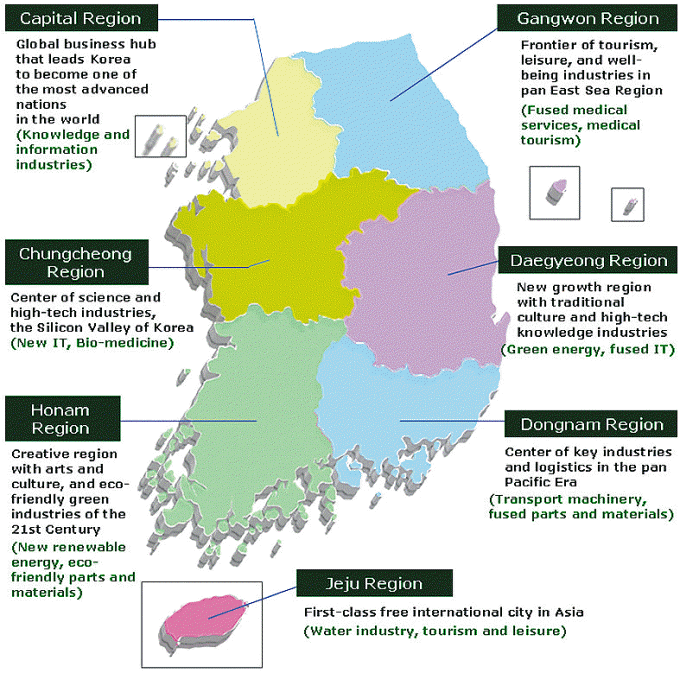All the regions to equally enjoy a quality life in Korea
We are committed to improving global competitiveness of the regions based on specialized and linkage development among Economic Regions.
- Creation of Economic Regions with global competitiveness
Economic Region is intended to effectively improve regional competitiveness based on inter-regional networking and cooperation. Economic Region is designated by the Presidential Decree taking into account economic and industrial areas, and historical and cultural homogeneity.

- Capital Region: Global business hub to lead the nation to become an advanced country
- Chungcheong Region: Silicon Valley of Korea as center for science and technology, and for high-tech industries
- Honam Region: 21st-century creative region of culture and arts, and of green growth
- Daegyeong Region: New growth zone of traditional culture and high-tech knowledge industries
- Dongnam Region: Hub of infrastructure and logistics industries in the Pacific Rim Era
- Gangwon Region: Frontier of tourism and relaxation, and of well-being industry in the East Coast Rim
- Jeju Region: First-class free international city in Asia
- Establishment of Related Infrastructure
- To expand supply of development land
- To revamp the legal system
- Promotion of Leading Projects
- To nurture leading industries
- To cultivate regional work force
- To establish infrastructure
- Establishment of Promotion Structure
- To establish Economic Region Development Committees
- To set up Economic Region development plans
Economic Regions (ERs) have been drawn up with consideration of the regions’ economic and industrial structure, historical continuity and cultural homogeneity. This scheme is designed to improve regional competitiveness via interaction and cooperation among smaller, individual regions. The rescaling was made on the basis of population size, industrial agglomeration, location, infrastructure, historical and cultural characteristics, and local administration and sentiment. The nation’s 7 metropolises and 9 provinces were regrouped into five ERs (the Capital Region, Chungcheong Region, Honam Region, Daegyeong Region, and Dongnam Region), each with a population of more than 5 million, plus two relatively small ERs (Gangwon Region and Jeju Region) with a population of about 1 million each.
This scheme is designed for integrated regional development on a bigger territorial scale by encouraging cooperation and coordination between local governments within each ER.
The promotion of new growth engine industries and key infrastructure projects is now being carried out at the ER level. The policy is to build regional economies comparable to the Capital Region by encouraging each ER to enhance its competitiveness and create jobs. The three main projects for the ERs are:
1) ?the priority provision of 30 infrastructure projects
2) ?the selective investment of two leading industries for each ER
3) ?the designation of hub universities to match up with the demands of the leading industries.
The government set the institutional framework for the new regional development policy by revising the Special Act on Balanced National Development (“the Special Act” hereafter) in April 2009.
Under this act, the 5-year National Plan for Regional Development is currently being formulated. Consisting of both the Sectoral Development Plan and the Economic Region Development Plan, this is a comprehensive national plan for enhancing regional competitiveness and promoting cooperative networking among regions.
For the implementation of the policy and programs for the economic regions (ERs), the Economic Region Development Committee (ERDC) was established as a standing and independent agency. Regional plans were prepared in 2009 and annual action plans are presently being drafted by each ERDC.










![[프로그램입력]](../../images/nav/nav_off_01.gif)
![[프로그램입력]](../../images/nav/nav_off_02.gif)
![[프로그램입력]](../../images/nav/nav_off_03.gif)
![[프로그램입력]](../../images/nav/nav_off_04.gif)
![[프로그램입력]](../../images/nav/nav_off_05.gif)








